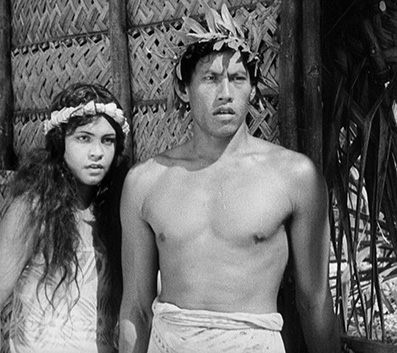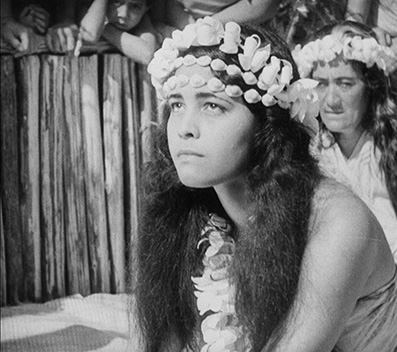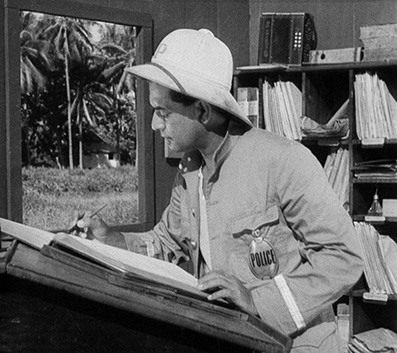|
When I first heard about the 1931 feature Tabu: A Story of the South Seas I was surprised in a way that rather neatly exposed my own oddly formed preconceptions about filmmakers and the films they choose to make. What caught me out was the idea that two directors as seemingly diverse as F.W. Murnau and Robert Flaherty would unite on a single project. But why in hell not? Both were acknowledged masters of their craft and doubtless had a healthy respect for each other's work, and what filmmaker would not want to collaborate with someone whose work they admire, no matter how great their own personal standing?
It later occurred to me that the source of my surprise lay in part with a buried tendency to associate a particular filmmaker with the first film of theirs that I saw, which painted an initial picture in my head of Tabu as a cross between Nosferatu and Nanook of the North (thinking about it now, that sounds like a film I'd happily pay to see). But there's logic behind this foolishness. Flaherty was primarily a maker of ethnographic documentaries, while Murnau was a creator of strikingly inventive dramatic works. On paper this makes them seem more like Celebrity Death Match opponents than a ideal partners on a feature of any description. But both men were genuine pioneers in their chosen fields and the project was apparently one Murnau had cherished for years. And given the strong ethnographic element to the story, who better collaborate with than Flaherty? That the two quickly fell out is perhaps unsurprising given that they were both men of vision with strongly held notions of the form their films should take, and stories suggest Murnau was not one easily given to compromise. It's thus Murnau who ended up in the director's chair and he who has ended up with the lion's share of the credit for what really is an extraordinary film.
As with the other two recent Blu-ray re-releases from Masters of Cinema, Kuroneko and The Naked Island, I've already covered the film itself in the earlier DVD review, which you can read here.
The main issue facing this Blu-ray upgrade of the 2008 Masters of Cinema DVD is that the earlier transfer was so damned good that it seemingly left little room for improvement. Obviously if you have a top-of-the-range 100-inch HD screen then you're quickly going to notice a difference between a PAL transfer sourced from an HD master and a 1080p HD transfer, but on a smaller screen, coupled with a player good upscaling capabilities, the difference is likely to seem less dramatic. But make a side-by-side comparison between the two discs and the differences are immediately apparent, not just in the increased level of fine detail but in the subtleties of the contrast range.
Also more visible here is the film grain, and while some non-purists might see this as a fault, for those of us who shudder and the negative effects of digital noise reduction, the grain is as much part of the picture as its tonal range. The transfer has been sourced from the same Murnau-Stiftung / Luciano Berriatúa 75th anniversary restoration as the previous DVD transfer and the incidents of remaining damage are thus identical on both discs, though have been brought into sharper focus by the increase in resolution here, a small price to pay for an otherwise fine transfer of a film of this age and importance.



A key difference of the new transfer is that it has restored the film's original aspect ratio of 1.19:1, compared to the 1.37:1 of the previous DVD release, which results in markedly more picture information at the top and bottom of screen (see frame grabs below).

The new 1.19:1 Blu-ray transfer (above) compared to the 1.37:1 DVD transfer (below)

The Linear PCM 48 mono 2.0 soundtrack displays, perhaps unsurprisingly, the same strengths and restrictions as the Dolby mono track on the DVD, which is no bad thing for one of the earliest synchronised music tracks in cinema history. Full marks to Masters of Cinema for not commissioning a re-recording of the track, which would have dramatically boosted the dynamic range but would be inauthentic to the film as it was originally screened.
Two (well, three) of the extra features included here been ported over from the earlier DVD release, but that's no bad thing at all, particularly as they have been expanded on for this edition. Some of the comments below have thus been reproduced from those on my original DVD review, with a couple minor amendments where appropriate.
Commentary by R. Dixon Smith and Brad Stevens
One of those expert commentaries that it would be terribly easy to be cynical about, particularly the way Smith and Stevens discuss motifs and meanings that you can't initially help thinking were probably more the result of logic or coincidence than planning (Hitu's slow movement, for instance, could be passed off as a common trait of characters in positions of authority), but their arguments become increasingly persuasive as the film progresses and some of those motifs are repeated with obvious purpose. They provide useful detail on the material cut or altered for the Paramount and Samuel Brown versions and are clearly huge admirers of a film they regard as Murnau's masterpiece.
Tabu – The Cinematic Legacy (14:53)
A documentary made by Luciano Berriatúa as part of the series for F.W. Murnau-Stiftung that kicked off with the one you'll find on the Masters of Cinema Nosferatu DVD. Although considerably shorter than its predecessor, the programme is busy with useful material, including the Murnau/Walter Spies concept of 'architectural cinematography', a side-by-side compassion of two angles of the same shots, and footage not used in the film that was recycled by Murnau's brother Robert Plumpe for his own short films. The included extracts from the feature give you a good idea how it looked before the Murnau-Stiftung restoration.
Deleted Scenes (15:26)
Not the usual collection of cut sequences, but a short documentary in which they are showcased,with alternative takes of individual sequences compared (including a dance sequence in which the female dancers are alternately bare-chested and covered up to avoid American censorship) and all of the angles of others are run one in sequence. A commentary (in German with English subtitles) provides a detailed explanation of what we are watching and also covers details about the technical aspects of the shoot and film processing. Usefully, we are informed whether footage was shot by Robert Flaherty or Floyd Crosby – so close are they stylistically that you'd be pushed to work it out otherwise. A fascinating piece.
Treibjagd in der Südsee (Dive Hunting in the South Seas) (11:34)
A short film constructed in 1940 from footage unused by Murnau showing a manner of fishing specific to this South Sea Island where if a shoal of fish swims into the bay, almost everyone in the community rush into the sea, seal off the bay, drive the fish towards the shore and kill them with spears. Excitingly edited and scored and peppered with unexpected cutaways, usually involving children, who catch a turtle, hang on to the back of a speeding boat and, more alarmingly, get run over by a canoe and clobbered in the face with an oar.
Booklet
At first glance the booklet looks to be the same as the one that accompanied the DVD release, complete with identical cover artwork and opening pages, and given that this was one of most comprehensive Masters of Cinema booklets to date this has to be good news. A flick through both documents, however, reveals a few minor changes to the layout and, more crucially, the absence here of Turia, an Original Story and Tabu (Taboo), A Story of the South Seas by F.W. Murnau and Robert J. Flaherty, a short essay on the film by Lotte Eisner, and a few film stills. What remains, however, is still substantial: Sunrise in Bora Bora, an updated and detailed 1990 essay on the film by Scott Eyman, including a map of the region in which the filming took place; Flaherty and Tabu, a 1959 Film Culture article by Richard Griffith; Flaherty's Hollywood Period: The Crosby Version, a revealing interview with cameraman Floyd Crosby from 1976; A Story of the South Seas in Letters and Telegrams, a collection of extracts from telegrams and letters sent by and to Murnau during the shoot, including reproductions of actual documents; The Fire Spirit of Bora Bora: A Ghostly Experience from Murnau's South Pacific Diary, a newly translated article written by Murnau and originally published in 1940.
If you don't already own the previous Masters of Cinema DVD then this is a no-brainer, but even if you do have it then I'd seriously consider upgrading, for the improvements in picture quality, for the correctly framed picture and for the additional extra features. Even more so than the DVD, this comes highly recommended, but hang on to the DVD for those extra articles in the booklet.
|